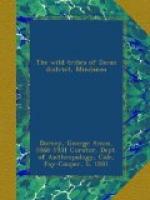Individual warriors lie in ambush for their foes, but when a great raid is planned the party is under the command of a bagani. These attacks are arranged to take place during the full moon and the warriors usually assault a settlement which they think can be taken by surprise, and hence unprepared. It is very seldom that these people fight in the open, and invaders do not attempt a combat unless they feel sure of the outcome. If they find a house well protected they may attempt to fire it by attaching a torch to an arrow and shooting it into the grass roof, the occupants being slaughtered as they rush out. If one of the enemy puts up an especially good fight his body is opened and the warriors eat a portion of his heart and liver, thinking thus to gain in valor.
Mr. Maxey mentions the use of poisoned weapons in the neighborhood of Cateel, but the Mandaya of the south seem to be entirely ignorant of this custom, Maxey’s account of the preparation of the poison is as follows:
“The poison is, according to the writer’s informant, prepared as follows: A long bamboo is cut and carried to a tree called camandag.[1] The bamboo must be long enough to reach to the limit of the shadow cast by the tree to the trunk of the same, as the tree is so poisonous that it even affects those who stand beneath it. The bamboo has a sharp point which is stuck into the tree and receives the milk which exudes from the cut. After several days the bamboo is removed and the contents emptied into another bamboo which serves for a sheath or quiver for the arrows, these being placed in it point down. The slightest scratch will cause death. A peculiar thing about the tree from which the poison is extracted, is that the person extracting must not only not get under the tree, but must approach it from the windward, as the effects of even the odor are unpleasant and dangerous.”
[1] Croton tiglium L.
INDUSTRIES
In the description of the tribe up to this point we have touched upon those pursuits which engross the greater part of the time. In addition to these, it falls to the lot of the women to manufacture and decorate all the clothing worn by members of the tribe. Some cotton is grown and is used in the manufacture of jackets, but the bulk of the garments are of hemp. In the description of the Decorative Art we shall deal with the decoration of the hemp cloth skirts worn by the women. Here it is only necessary for us to observe that this cloth is produced and colored by exactly the same process as is employed by the Bagobo women.[2]
[2] See p. 79.
A very little brass casting is done by the Mandaya of one district, but it is evidently a crude copy of Moro work. By far the greater part of the brass betel boxes, and ornaments of that metal, as well as spear heads, are purchased from the coast Mohammedans.
Iron working is an ancient art with this people and the beauty and temper of their knives and daggers is not excelled by the output of any other Philippine tribe. In the manufacture of these weapons they employ the same methods as their neighbors to the south and west.




